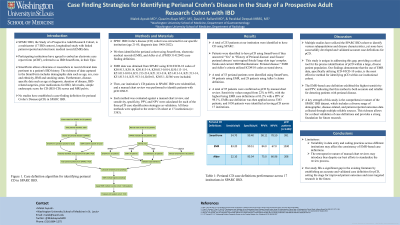Tuesday Poster Session
Category: IBD
P4329 - Case Finding Strategies for Identifying Perianal Crohn’s Disease in the Study of a Prospective Adult Research Cohort With IBD
Tuesday, October 29, 2024
10:30 AM - 4:00 PM ET
Location: Exhibit Hall E

Has Audio

Malek Ayoub, MD
Washington University School of Medicine in St. Louis
St. Louis, MO
Presenting Author(s)
Malek Ayoub, MD1, Quazim Alayo, MD, MSc1, David Ballard, MD1, Parakkal Deepak, MBBS, MS2
1Washington University School of Medicine in St. Louis, St. Louis, MO; 2Washington University in St. Louis, St. Louis, MO
Introduction: The Study of Prospective Adult Research Cohort of IBD (SPARC IBD) is a prospective, longitudinal cohort study of patients with inflammatory bowel diseases (IBD) ages 18 and older managed according to local standards at 17 academic medical centers in the US. No studies have established a case-finding definition for perianal CD (pCD) in SPARC IBD.
Methods: SPRC IBD Crohn’s disease (CD) cohort was extracted for our specific institution (age 21-85, diagnosis date 1960-2022). We then identified the perianal cohort using SmartForm, electronic medical records (EMR), and Adler et al. (PMID 31412045) case finding definition. EMR data was obtained from SPARC using ICD-9/ICD-10 codes of K50.913, K50.14, K50.813-14, K50.013-0.014, K50.113-114, K51.013-0.014, K51.213-214, K51.313-314, K51.413-14, K51.513-14, K51.813-14, K51.913-14, K60-61, K565.1, K566 were included. Then, our institution’s CD patients in SPARC IBD were reidentified, and a manual chart review was performed to identify patients with pCD ONLY. Each method was evaluated against a manual chart review, and sensitivity, specificity, PPV, and NPV were calculated for each of the three pCD case identification strategies as validation. All three methods were then applied to the entire CD cohort at 17 institutions (n= 3383).
Results: A total of 253 patients at our institution were identified to have CD using SPARC. Patients were identified to have pCD using SmartForm if they answered “Yes” to “History of Perianal disease/ anal fissure/ perianal abscess/ rectovaginal fistula/ large skin tags/ complex fistula and current IBD Manifestations: Perianal disease.” EMR and Adler’s criteria utilized ICD9/10 codes as stated above.1 A total of 53 perianal patients were identified using SmartForm, 94 patients using EMR, and 28 patients using Adler’s claims definition. A total of 95 patients were confirmed as pCD by manual chart review. Sensitivity values ranged from 22% to 84%, with the highest being EMR case definitions at 83.16% with a PPV of 98.11%. EMR case definition was then applied across 3383 patients (17 institutions), and 1030 patients were identified as having pCD.
Discussion: Our findings demonstrate that the use of EMR data, specifically utilizing ICD-9/ICD-10 codes, is both accurate and reliable for detecting patients with pCD in the SPARC IBD cohort. Our study fills a significant gap in the existing literature by establishing an accurate and validated case definition for pCD.

Note: The table for this abstract can be viewed in the ePoster Gallery section of the ACG 2024 ePoster Site or in The American Journal of Gastroenterology's abstract supplement issue, both of which will be available starting October 27, 2024.
Disclosures:
Malek Ayoub, MD1, Quazim Alayo, MD, MSc1, David Ballard, MD1, Parakkal Deepak, MBBS, MS2. P4329 - Case Finding Strategies for Identifying Perianal Crohn’s Disease in the Study of a Prospective Adult Research Cohort With IBD, ACG 2024 Annual Scientific Meeting Abstracts. Philadelphia, PA: American College of Gastroenterology.
1Washington University School of Medicine in St. Louis, St. Louis, MO; 2Washington University in St. Louis, St. Louis, MO
Introduction: The Study of Prospective Adult Research Cohort of IBD (SPARC IBD) is a prospective, longitudinal cohort study of patients with inflammatory bowel diseases (IBD) ages 18 and older managed according to local standards at 17 academic medical centers in the US. No studies have established a case-finding definition for perianal CD (pCD) in SPARC IBD.
Methods: SPRC IBD Crohn’s disease (CD) cohort was extracted for our specific institution (age 21-85, diagnosis date 1960-2022). We then identified the perianal cohort using SmartForm, electronic medical records (EMR), and Adler et al. (PMID 31412045) case finding definition. EMR data was obtained from SPARC using ICD-9/ICD-10 codes of K50.913, K50.14, K50.813-14, K50.013-0.014, K50.113-114, K51.013-0.014, K51.213-214, K51.313-314, K51.413-14, K51.513-14, K51.813-14, K51.913-14, K60-61, K565.1, K566 were included. Then, our institution’s CD patients in SPARC IBD were reidentified, and a manual chart review was performed to identify patients with pCD ONLY. Each method was evaluated against a manual chart review, and sensitivity, specificity, PPV, and NPV were calculated for each of the three pCD case identification strategies as validation. All three methods were then applied to the entire CD cohort at 17 institutions (n= 3383).
Results: A total of 253 patients at our institution were identified to have CD using SPARC. Patients were identified to have pCD using SmartForm if they answered “Yes” to “History of Perianal disease/ anal fissure/ perianal abscess/ rectovaginal fistula/ large skin tags/ complex fistula and current IBD Manifestations: Perianal disease.” EMR and Adler’s criteria utilized ICD9/10 codes as stated above.1 A total of 53 perianal patients were identified using SmartForm, 94 patients using EMR, and 28 patients using Adler’s claims definition. A total of 95 patients were confirmed as pCD by manual chart review. Sensitivity values ranged from 22% to 84%, with the highest being EMR case definitions at 83.16% with a PPV of 98.11%. EMR case definition was then applied across 3383 patients (17 institutions), and 1030 patients were identified as having pCD.
Discussion: Our findings demonstrate that the use of EMR data, specifically utilizing ICD-9/ICD-10 codes, is both accurate and reliable for detecting patients with pCD in the SPARC IBD cohort. Our study fills a significant gap in the existing literature by establishing an accurate and validated case definition for pCD.

Figure: Figure 1. Case definition algorithm for identifying perianal CD in SPARC IBD.
Note: The table for this abstract can be viewed in the ePoster Gallery section of the ACG 2024 ePoster Site or in The American Journal of Gastroenterology's abstract supplement issue, both of which will be available starting October 27, 2024.
Disclosures:
Malek Ayoub indicated no relevant financial relationships.
Quazim Alayo indicated no relevant financial relationships.
David Ballard: Merck – Consultant.
Parakkal Deepak: AbbVie – Consultant, Grant/Research Support. Alimentiv – Grant/Research Support. Arena Pharmaceuticals – Grant/Research Support. Boehringer Ingelheim – Grant/Research Support. Bristol Myers Squibb-Celgene – Advisory Committee/Board Member, Grant/Research Support. CorEvitas LLC – Consultant. Janssen – Grant/Research Support. Pfizer – Grant/Research Support. Prometheus Biosciences – Grant/Research Support. Roche/Genentech – Advisory Committee/Board Member. Scipher Medicine – Grant/Research Support. Takeda – Grant/Research Support.
Malek Ayoub, MD1, Quazim Alayo, MD, MSc1, David Ballard, MD1, Parakkal Deepak, MBBS, MS2. P4329 - Case Finding Strategies for Identifying Perianal Crohn’s Disease in the Study of a Prospective Adult Research Cohort With IBD, ACG 2024 Annual Scientific Meeting Abstracts. Philadelphia, PA: American College of Gastroenterology.
